Pet food facts-and fiction
Cant stomach the dizzying array of pet food trends, fads and marketing tactics inundating the market? Lets demystify some of the most common misconceptions so you can counsel your clients with confidence.
Chances are, clients ask you several times a day about pet foods: What should I feed my pet? Should it be grain-free? Gluten-free? What about raw diets?

It's becoming a more and more difficult conversation, as our views on nutrition may contradict national marketing campaigns or grassroots fads that have little or no basis in proper pet food nutrition. When I discuss foods with veterinarians, I often find that some of us have jumped on the fad bandwagon as well-it's easy to do. But the only way to provide our clients with the best nutritional advice and the truth about pet foods is to thoroughly investigate the products we're recommending. I hope this article will help you gain the information and expertise you need to recommend diets with confidence.
Identify the real manufacturer
First of all, let's identify the criteria for a high-quality pet food manufacturer: Does the manufacturer make the food in its own facility? Does it employ a board-certified veterinary nutritionist? Does it have an American Feed Control Officials (AAFCO) feeding trial statement? Does the company practice strict quality control measures and conduct and publish research on animal nutrition? Does the pet food bag read “manufactured by” as opposed to “distributed by” or “manufactured for”? Many foods are co-packed, or made by several different manufacturers then labeled by the end-of-the-line company that sells it.
A great place to start your research is with the annual pet food manufacturer list published by Whole Dog Journal. An example from its 2013 list was Blue Buffalo, which was reportedly made by five different manufacturers-American Nutrition, C.J. Foods, ProPet, Triple T Foods and Tuffy's Pet Foods. Recently Blue Buffalo built a multimillion-dollar facility of its own in Missouri with the idea of bringing its product in house.1

The flip side of co-packing is mass manufacturing. Take Diamond Pet Foods, for example, the manufacturer behind at least 30 different pet foods, including Chicken Soup for the Pet Lover's Soul, Canidae, Kirkland, Solid Gold Wolf King, Taste of the Wild, 4 Health, Professional and Premium Edge, to name a few. Diamond Pet Foods' Gaston, South Carolina, plant was also home to a national Salmonella enterica outbreak, which led to the largest recall of dry pet foods. More than 30,000 tons of food were recalled after a New Jersey infant became severely ill from contact with Costco's Kirkland brand pet food.2 Most recently (2012), a sample of Diamond Pet Foods' lamb-based food from its Meta, Missouri, plant tested positive for Salmonella liverpool, but no human illness was reported.2 Why such ongoing problems? Unfortunately regulatory agencies don't require manufacturers to test their final pet food products for Salmonella. That's why it's important to ask your favorite manufacturer if it implements routine testing as part of its quality control standards.
If your favorite brands aren't listed in Whole Dog Journal's annual rundown of the best dry dog foods, consider calling or emailing the individual companies to ask whether they manufacture their food in house, employ a veterinary nutritionist, practice strict quality control measures and conduct nutritional research.
Don't trust what you read
Another problem for veterinary professionals is guaranteeing that the label ingredients are actually present in the food. A recent article reported that 20 of the 52 foods that were PCR-tested for ingredients showed a discrepancy between labeled ingredients and what was in the actual diet.3 This study found the most common ingredient was chicken and that the 20 mislabeled foods either had additional proteins or none of the advertised proteins. Pork was the most common undeclared protein, and two foods claiming to contain beef had none at all. This can be a problem when clients are trying to avoid a potential food allergen for their pet.
Did you know?
If you hear a pet food manufacturer tout its product as “veterinarian-approved,” don't be fooled! It turns out that “veterinarian-approved” is not a term allowed on pet food labels. “Veterinarians do not approve labels or products, only state regulatory agencies can do that,” according to the Association of American Feed Control Officials. Pet food manufacturers can, however, use the terms “veterinarian-recommended,” “veterinarian-developed” or “veterinarian-formulated” if the company meets specific criteria set out by the association.

Another study found that four over-the-counter (OTC) venison diets also contained beef, corn and soy, which were not listed on the label.4 The four foods found to have additional ingredients not listed on the label were compared with Royal Canin's venison and potato, which was found to contain only venison and potato.
When trying to rule out food allergies, it appears that prescription limited-ingredient diets or supervised home-cooked diets are a better choice than OTC diets claiming to be limited-ingredient, as some of these foods don't live up to their promises. Another option for food-allergic pets is custom-blend diets.
Familiarize yourself with fad diets
“Grain-free” is the new buzzword for pet owners. The problem is that grain-free does not mean hypoallergenic, and there is no set AAFCO definition of “grain-free.” So grain-free can mean different things to different food manufacturers. What many owners don't realize is that dogs are of the carnivore species but are omnivores in their eating habits, so complex carbohydrates are actually necessary for normal stool formation. Obesity often thought to be a problem with high-carbohydrate foods is actually more of a concern with high-fat diets.
Many of today's pet owners are also gravitating toward raw food diets because “that's what animals eat in the wild” and “it's natural.” Of the 36 regions of genomes that differ between wolves and dogs, 10 play a role in digestion and metabolism, indicating legitimate nutritional differences between the two. Wild animals have a short lifespan, and these raw diets may not provide proper and complete nutrition for the long life our domestic pets enjoy.

Unfortunately most reports concerning raw diets are anecdotal with a lack of long-term, high-quality studies. Most raw diets are labeled as supplements or for intermittent feeding only-not for long-term nutrition. A recent article reviewed the scientific evidence for and against raw diets and reported that 60 percent of recipes used in homemade raw diets were found to have nutritional imbalances.5 In an earlier study, all five raw diets (three home-cooked, two commercially prepared) tested had an incorrect calcium/phosphorus ratio, vitamin A and E deficiencies and twice the AAFCO-recommended amount of vitamin D.5
Safety risks for freezing and freeze-dried raw diets are also a concern, as freezing does not destroy all pathogens. An estimated 20 percent to 48 percent of commercial raw diets had been found to be contaminated with Salmonella. Chicken purchased for human consumption carries 21 percent to 44 percent Salmonella contamination. Another study found that one-third of raw dog or cat foods ordered online were contaminated with Listeria.6
“Enzymes” are another touted benefit of raw diets, yet most dogs and cats do not require exogenous enzymes for digestion. Some pets receiving raw diets do have improved digestion, as heat commonly used in manufacturing commercial pet foods can affect protein digestibility but improves plant digestibility. Blood work abnormalities for raw diet eaters include increased lymphocyte and IgG production, elevated thyroxine concentrations and changes in blood urea nitrogen concentrations,5 necessitating periodic physical examination, urinalysis, complete blood count and serum chemistry profile evaluation.
Engage breeders
Recent research suggests that breeders know little about pet nutrition in pregnant female dogs, whelping females and puppies. Yet less than half of breeders consult with veterinarians regarding nutrition for gestation, lactation or puppy nutrition. One study found that 16.9 percent of breeders who fed commercial diets did not feed one intended for gestation and lactation.7 And 8.7 percent of breeders fed a diet to puppies not adequate for growth. AAFCO requires separate nutritional profiles for gestation and lactation. Commercial diets must state on the label whether they are adequate for a particular life stage and have undergone feeding trials for that stage. If the diet states it has met all AAFCO requirements for all life stages and has been fed in feeding trials for those stages, then it has been fed and tested for gestation, lactation and growth.
Allergy trials done right
Most clients think that eliminating “wheat” or grains from the diet is all that's needed to rule out a food allergy, but patients must avoid corn, wheat, egg, beef, chicken, soy, dairy and any other previously fed protein during the eight- to 10-week diet trial.

In the study mentioned above,7 a main concern was that gestational dogs were being fed a maintenance diet and not receiving the enhanced nutrition needed in gestation and lactation. Fifteen percent of breeders fed a home-cooked diet, and, of those, one-third did not use a recipe to formulate the diet. Up to one-third of breeders surveyed fed raw diets or bones, which increases the exposure to Salmonella, Listeria, Campylobacter, Escherichia coli, Toxoplasma, Trichinella and so on. As found in previous studies, the nutritional value of raw diets is concerning, particularly in gestation, lactation and puppy growth stages. Consulting with breeders is an area in which we need to engage to combat old wives' tales about what's “good” nutrition-and despite the fact that old habits die hard.
Conclusion
It's important to fight the daily battle against misleading marketing and Internet “knowledge” to provide clients with the best possible information about their pets' health. In my practice I recommend the larger pet food manufacturers, including Hill's, Iams, Royal Canin and Nestlé Purina. They generally manufacture in house, employ board-certified veterinary nutritionists, publish nutritional research in peer-reviewed journals, adhere to strict quality-control measures, actually feed their food via AAFCO feeding trials (not all companies do this) and can provide a complete nutritional analysis of their products. When there is control of all aspects of research, development and manufacturing, there is a sense of pride and responsibility for the products these companies are offering our pets.
References
1. Kerns N. Whole Dog Journal's 2013 dry dog food review. Whole Dog J 2013;16(2)2;7-11.
2. Imanishi M, Rotstein DS, Reimschuessel R, et al. Outbreak of Salmonella enterica serotype Infantis infection in humans linked to dry dog food in the United States and Canada, 2012. J Am Vet Med Assoc 2014;244(5):545-553.
3. Okuma TA, Hellburg RS. Identification of meat species in pet foods using a real-time polymerase chain reaction (PCR) assay. Food Control 2015;50:9-17.
4. Raditic DM, Remillard RL, Tater KC. ELISA testing for common food antigens in four dry dog foods used in dietary elimination trials. J Anim Physiol Anim Nutr 2011;95(1):90-97.
5. Freeman LM, Chandler ML, Hamper BA, et al. Current knowledge about the risks and benefits of raw meat-based diets for dogs and cats. J Am Vet Med Assoc 2013;243(11):1549-1558.
6. Nemser SM, Doran T, Grabenstein M, et al. Investigation of Listeria, Salmonella, and toxigenic Escherichia coli in various pet foods. Foodborne Pathog Dis 2014;11(9):706-709.
7. Connolly KM, Heinze CR, Freeman LM. Feeding practices of dog breeders in the United States and Canada. J Am Vet Med Assoc 2014;245(6):669-676.
Suggested reading:
> Epperley LA. Nutritionists offer vets pet food talking points. Vet Pract News Sept 2012;41-55.
> Carter RA, Bauer JE, Kersey JH, et al. Awareness and evaluation of natural pet food products in the United States. J Am Vet Med Assoc 2014;245(11):1241-1248.
Dr. Jeromin is a pharmacist and veterinary dermatologist in private practice in Cleveland, Ohio. She is a 1989 graduate of The Ohio State University College of Veterinary Medicine and an adjunct professor at Case Western Reserve University's College of Medicine.